North American F-86 Sabre
[7] Initial proposals to meet a United States Army Air Forces (USAAF) requirement for a medium-range, single-seat, high-altitude, jet-powered day escort fighter/fighter bomber were drafted in mid-1944.[10] These data showed that a thin, swept wing could greatly reduce drag and delay compressibility problems that had bedeviled fighters such as the Lockheed P-38 Lightning when approaching the speed of sound.[18][Note 1] The F-86A set its first official world speed record of 671 miles per hour (1,080 km/h) on September 15, 1948, at Muroc Dry Lake, flown by Major Richard L. Johnson, USAF.[19] Five years later, on 18 May 1953, Jacqueline Cochran became the first woman to break the sound barrier, flying a "one-off" Canadian-built F-86 Sabre Mk 3, alongside Chuck Yeager.On 2 February 1958, a team of Pakistan Air Force F-86 Sabres called "Falcons" set a world record at PAF Base Masroor by performing a loop while in a 16 aircraft diamond formation.[citation needed] The API rounds used during the Korean War contained magnesium, which were designed to ignite upon impact, but burned poorly above 35,000 ft (11,000 m) as oxygen levels were insufficient to sustain combustion at that height.[25] The transition to the Sabre's swept wings and jet engine saw many accidents and incidents, since even experienced pilots had to learn new handling techniques and flying characteristics.Early on in the jet age, some US manufacturers instituted safety and transition programs where experienced test and production pilots toured operational fighter squadrons to provide instruction and demonstrations designed to lower the accident rate.Despite being able to fire only two of the four 20 mm cannon at a time, the experiment was considered a success and signaled the end of the decades-long use of the Browning .50 caliber in the air-to-air role.[34] The MiGs flown from bases in Manchuria by Chinese, North Korean, and Soviet VVS pilots were pitted against two squadrons of the 4th Fighter-Interceptor Wing forward-based at K-14, Kimpo, Korea.[28] The North Koreans and their allies periodically contested air superiority in MiG Alley, an area near the mouth of the Yalu River (the boundary between Korea and China) over which the most intense air-to-air combat took place.One scored a hit on the 802nd Engineer Aviation Battalion's motor pool, damaging some equipment, and two bombs burst on the flightline of the 335th Fighter Interceptor Squadron.[35] By the end of hostilities, F-86 pilots were initially credited by American sources with shooting down 792 MiGs for a loss of only 78 Sabres in air-to-air combat, a victory ratio of 10:1.[37] Internally, the USAF accepted that its pilots had actually downed about 200 MiGs[38] Soviet data records only 335 MiG-15s in Korea to all causes, including accidents, antiaircraft fire, and ground attacks.Former Communist sources now acknowledge Soviet pilots initially flew the majority of MiG-15s that fought in Korea, but they also dispute that more MiG-15s than F-86s were shot down in air combat.[32][45] The status of many claimed air-to-air victories in the Korean War has been increasingly debated as more data becomes available, showing that instances of over-claiming abounded on both sides.Under a secret effort designated Operation Black Magic, the U.S. Navy had provided the ROC with the AIM-9 Sidewinder, its first infrared-homing air-to-air missile, which was just entering service with the United States.A small team from VMF-323, a Marine FJ-4 Fury squadron with later assistance from China Lake and North American Aviation, initially modified 20 of the F-86 Sabres to carry a pair of Sidewinders on underwing launch rails and instructed the ROC pilots in their use flying profiles with USAF F-100s simulating the MiG-17.15 Squadron "Cobras" shot down an Indian Canberra Spy Plane over Rawalpindi marking the first aerial victory for the Pakistan Air Force.In late 1960, regular and irregular Afghan forces invaded the Bajaur area of North West Frontier Province in an attempt to annex the region.[61][62][63] In the air-to-air combat of the Indo-Pakistani War of 1965, the PAF Sabres claimed to have shot down 15 Indian Air Force (IAF) aircraft, comprising nine Hunters, four Vampires, and two Gnats.[79] In East Pakistan, the F-86Es of the Tail Choppers took active part in several CAS and COIN missions against Mukti Bahini militants and irregular Indian forces.[73] On 15 April 1971, a formation of 4 Sabres led by Flight Lt. Abbas Khattak strafed and rocketed many rebel strongholds at Bhairab Bazar to support the Pakistan Army's efforts in re-capturing food stocks and silos from the Mukti-Bahini militants.[73][80][81] On 26 April 1971, Flight Lt. Abbass led another Sabre formation at Patuakhali where surviving rebels had regrouped after facing a defeat at Barisal by the hands of the Army.[73] On the Western Front, F-86Es and F-86Fs from various PAF squadrons played a vital role in backing the Pakistan Army's counter attacks at several sectors with Air support.Although ill-equipped for anti-tank roles, the Sabres were modified to carry general purpose bombs in an effort to provide as much effective air support as possible.17 Squadron "Tigers" flew 55 CAS sorties in support of the IV Corps offensive in which they claimed 6 Indian tanks and a number of military vehicles destroyed.[89][90] Two types based on the U.S. F-86F were built under licence by the Commonwealth Aircraft Corporation (CAC) in Australia, for the Royal Australian Air Force as the CA-26 (one prototype) and CA-27 (production variant).[94] The CAC Sabres included a 60% fuselage redesign, to accommodate the Rolls-Royce Avon Mk 26 engine, which had roughly 50% more thrust than the J47, as well as 30 mm Aden cannon and AIM-9 Sidewinder missiles.[96] CA-27 marques: The F-86 was also manufactured by Canadair in Canada as the CL-13 Sabre to replace its de Havilland Vampires, with the following production models: Note: The costs are in approximately 1950 United States dollars and have not been adjusted for inflation.

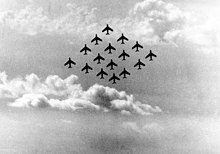











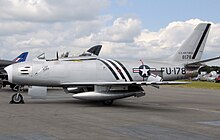






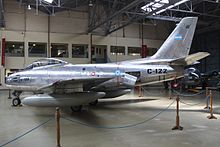
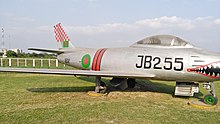









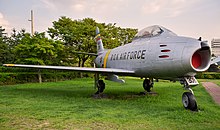


Heritage FlightDavis-Monthan AFBFighter aircraftManufacturerNorth American AviationUnited States Air ForceJapan Air Self-Defense ForceSpanish Air ForceRepublic of Korea Air ForceNorth American FJ-1 FuryCanadair SabreNorth American FJ-2/-3 FuryCAC SabreNorth American F-86D SabreNorth American FJ-4 FuryNorth American YF-93North American F-100 Super Sabretransonicswept-wingMiG-15Korean WarFJ-2s and -3smost-produced Western jet fighterP-51 MustangWorld War IIFJ-1 FuryUnited States Army Air Forcesescort fighterfighter bomberflight research data seizedLockheed P-38 Lightningswept-back wingNACA four-digit airfoilsMesserschmitt Me 262George WelchEdwards AFBStrategic Air CommandCanadair, LtdJackie CochranChuck Yeagerworld speed recordRichard L. JohnsonJacqueline CochranPakistan Air Forceworld recordPAF Base MasroorZafar Masudfighter-interceptorfighter-bomberGeneral Electric J35-C-3ChevroletAllisonGeneral Electric J47-GE-7General Electric J73-GE-3National Air and Space Museum4th Fighter-Interceptor WingnapalmrocketsM3 Browning machine gunsharmonizedtracermagnesiumMark 18 manual-ranging computing gun sightall-flying tailleading edge slatswing fence1972 Sacramento Canadair Sabre accidentSuwon Air Base1st Fighter Wing94th Fighter Squadronceilingzoom climbBrowning .50 calibertailplaneNellisrules of engagement51st Fighter-Interceptor WingNo. 2 SquadronSouth African Air ForceManchuriaK-14, KimpoMiG AlleyPolikarpov Po-2Vought F4U CorsairMikoyan-Gurevich MiG-15Republic of China Air ForceTaiwanSecond Taiwan Strait CrisisChinese CommunistsNationalistsQuemoycombat air patrolPeople's Liberation Army Air ForceMiG-17sAIM-9 Sidewinderinfrared-homingair-to-air missileVMF-323FJ-4 FuryChina LakeMasroor AirbasePakistanMutual Defense Assistance Programshot downCanberra Spy PlaneRawalpindiex-LuftwaffeCL-13 Mk.6sUS sanctionsShenyang F-6PAF MuseumBajaur CampaignBajaurNorth West Frontier ProvincePakistani ForcesPakistani PashtunRoyal Afghan ArmyFrontier CorpsRoyal Afghan Air ForceMiG-17MiG-21Indo-Pakistani Air War of 1965Sharbat Ali ChangeziNo. 26 Squadron PAFHawker HunterLahore District